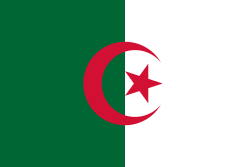History
Antiquity
Christianity was introduced to Algeria around the 2nd century AD. The popularity of Christianity after the edict of Milan is nowhere else as visible as in North Africa where many huge baptistries were built to facilitate the spread of the religion in the fourth century. At the same time, the Donatist heresy spread in Roman Africa, also enticing many who had grievances with the Roman state, until it was condemned by a commission in 313 AD. Nevertheless, Donatism persisted until the beginning of the fifth century when Augustine of Hippo turned the tide in favour of the Church of Rome.
When the Vandals conquered North Africa in the fifth century, their ruler Gaiseric began a full-scale persecution of Catholic Romans and Africans, banning all Catholic worship, seizing Catholic churches and targeting especially Catholic bishops, priests and deacons. While many were murdered or tortured, also lay people were massacred. After the reconquest by the Eastern Roman Empire, the Catholic faith was reintroduced. By the mid-seventh century, the majority of North Africa's population had been Christian for a long time, though it was far from homogenous and some remote autochthonous tribes remained pagan. The majority of Christians in the cities and towns was Catholic as were most bishops and clergy. Few Monotheletes existed and in 646 metropolitans in Mauretania, Numidia and Byzaca reportedly held synods which rejected Monotheletic doctrine and reported it to Pope Theodore I.
Medieval period
After the Muslim conquest of North Africa, indigenous Christian communities did not vanish immediately but disappeared in the eleventh and twelfth as part of a long and slow process. This growing weakness can be seen in the greater need of the North African church to look to Rome for help, especially as the shrinking communities and clergy meant that fewer bishops could settle disputes or consecrate new clergy. As such, Pope Gregory VII corresponded in 1076 both with the Catholic community of Bougie as well as with its ruler, Emir al-Nasir, who had written to Gregory, presenting him with gifts and asking him to ordain a certain Servandus as bishop.
A new chapter for the North African church begun in the thirteenth century when newcomers from Europe took up residence in the larger coastal towns. These included Christian captives, merchants as well as mercenaries hired by local Muslim rulers. In order to provide for their spiritual needs and administer rites, various orders such as the Trinitarians, Dominicans and Franciscans sent missions to North Africa with the aid of the popes.
Colonial period
A new era begun for the Church with the arrival of French forces in 1830, in which many settlers from France, Spain, Italy and Malta came to Algeria. After some early conflict about the application of the concordat between France and the Holy See and the right to appoint priests to Algeria, a papal bull announcing the creation of the diocese of Algiers resolved these issues tentatively in 1838. The new diocese was dependent on the Archdiocese of Aix-en-Provence and was under the authority of the concordate. The first bishop, Antoine-Adolphe Dupuch, arrived in Algiers with the relics of St. Augustine for which he commissioned a basilica to be built in the ruins of Hippo.
Cardinal Lavigerie founded the White Fathers in an effort to spread Christianity among the Muslims while intending to understand and respect the native culture. Charles de Foucauld, a hermit whose life and teaching inspired the foundation of many spiritual congregations, also encouraged the respect for the native religion and culture.
Prior to independence, Algeria was home to a million Catholic settlers (10%) who had a historic legacy and powerful presence. [3] Some Algerians of Berber (mostly Kabyle) or Arab descent converted to Christianity during the French colonialism. [3] [18]
After Algerian independence
Shortly after independence, some 900,000 European settlers departed, together with most of the native Christians of Algerian and Muslim origin. After a series of violence events over 1962 more than 80% of Catholic settlers left the country. [3] In the following years, the Church handed over 700 churches (which subsequently became mosques) and in 1976, the Church had to also hand over schools, hospitals and other social services as part of a nationalization program. After 1993, the assassination of foreign workers and the closure of all foreign schools meant that almost all Christian families left, including European spouses of Algerians, Coptic coopérants (Christian aid workers) and more native Algerian Christians. After the emigration and violence only about three thousand Catholics remained.
21st century
In 2020, Catholics made up 0.01-0.02% of the country's population; [21] [2] there were 62 priests and 116 nuns serving across 30 parishes.
In 2022, the Catholic Church noted that they were able to carry out religious services and prison visits without interference from the authorities. [22]
This page is based on this
Wikipedia article Text is available under the
CC BY-SA 4.0 license; additional terms may apply.
Images, videos and audio are available under their respective licenses.



